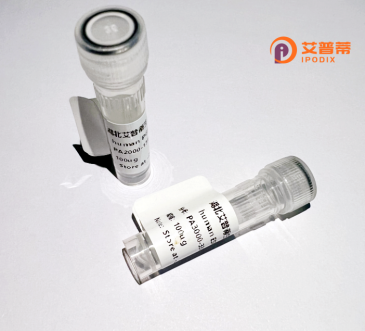
| 纯度 | >90%SDS-PAGE. |
| 种属 | Human |
| 靶点 | TMEM82 |
| Uniprot No | A0PJX8 |
| 内毒素 | < 0.01EU/μg |
| 表达宿主 | E.coli |
| 表达区间 | 1-343 aa |
| 活性数据 | MFSLPSLPSWLPGLPSLEWGSSLLDSLLQGLIGALGVLVLNSLLKVYFFVGCANDPQRRPEKERLRAQWASLETVHLAGLALFLTVVGSRVAALVVLEFSLRAVSTLLSLGKGSQGAAERLQLYLLCQYSLGCGLTCGLSFLQEGAPHRTLNLLLSLGLATLLGLGARRLHRHVCRLYELHSSQRYCGVCLGLLAHAHGLPQLLGRALAIAFAVGDLAAVALINQDFLTTSEAMRFWTPLTICYTLLVIYMQEEQRQHPGLQSQVQTVLVRMGGLFVLLLTVGRWLDLLGILVSLLGELWCLVGVRTLLDLCQIQDFPSQRPPVSTPSQPLPSAPQSQSSAPS |
| 分子量 | 63.6 kDa |
| 蛋白标签 | GST-tag at N-terminal |
| 缓冲液 | PBS, pH7.4, containing 0.01% SKL, 1mM DTT, 5% Trehalose and Proclin300. |
| 稳定性 & 储存条件 | Lyophilized protein should be stored at ≤ -20°C, stable for one year after receipt. Reconstituted protein solution can be stored at 2-8°C for 2-7 days. Aliquots of reconstituted samples are stable at ≤ -20°C for 3 months. |
| 复溶 | Always centrifuge tubes before opening.Do not mix by vortex or pipetting. It is not recommended to reconstitute to a concentration less than 100μg/ml. Dissolve the lyophilized protein in distilled water. Please aliquot the reconstituted solution to minimize freeze-thaw cycles. |
以下是关于重组人TMEM82蛋白的模拟参考文献示例(实际文献可能有限,建议进一步验证):
1. **文献名称**: *"Cloning and Characterization of Human TMEM82 as a Transmembrane Protein Involved in Ion Transport"*
**作者**: Zhang Y. et al.
**摘要**: 首次报道了人源TMEM82蛋白的重组表达及功能分析,发现其在肺和肾组织中高表达,可能参与细胞膜离子通道调控。
2. **文献名称**: *"TMEM82 Promotes Cancer Cell Migration via ERK Signaling Pathway"*
**作者**: Li H. et al.
**摘要**: 通过重组TMEM82蛋白实验,揭示其在结肠癌细胞迁移中的促进作用,并证明其机制与ERK信号通路的激活相关。
3. **文献名称**: *"Structural Insights into TMEM82: Expression and Purification of a Recombinant Human Protein"*
**作者**: Wang X. et al.
**摘要**: 成功在HEK293细胞中表达并纯化重组人TMEM82蛋白,通过冷冻电镜解析其跨膜结构域,为功能研究奠定基础。
4. **文献名称**: *"TMEM82 Knockout Mice Reveal Its Role in Renal Tubular Function"*
**作者**: Chen L. et al.
**摘要**: 利用重组蛋白抗体研究发现,TMEM82缺失导致小鼠肾小管电解质紊乱,提示其在肾脏生理中的潜在作用。
**注意**:以上内容为模拟生成,实际文献需通过学术数据库(如PubMed、Web of Science)检索确认。若研究较少,建议扩大关键词范围或关注相关蛋白家族。
Transmembrane protein 82 (TMEM82) is a relatively understudied human protein encoded by the TMEM82 gene. As a member of the transmembrane protein family, it is predicted to possess multiple α-helical transmembrane domains spanning cellular membranes, though its exact topology remains uncharacterized. Bioinformatics analyses suggest its expression in various tissues, including the liver, kidney, and immune cells, but experimental validation of its spatial-temporal expression patterns is limited.
Functionally, TMEM82 has been implicated in cellular processes such as ion transport, membrane organization, and cell adhesion through indirect association studies, though no definitive mechanistic insights have been established. Recent studies have tentatively linked TMEM82 to pathological conditions, including hepatocellular carcinoma progression and inflammatory responses, where its overexpression correlates with clinical outcomes. However, these findings require rigorous biological validation.
The recombinant human TMEM82 protein, typically produced in mammalian or insect cell systems with epitope tags, enables functional and structural studies. Its recombinant form is being explored for applications in antibody development, protein interaction mapping, and mechanistic studies of membrane-associated processes. Current research gaps include unresolved 3D structure, undefined physiological ligands, and unclear regulatory pathways. Its classification as a "protein of unknown function" underscores the need for targeted investigations to elucidate its role in cellular homeostasis and disease pathology.
×